The Wolf(Canis lupus)
The wolf’s first appearance was in 1992 in Vésubie in the Alpes-Maritimes, on its way from Italy. It has now settled all over the Alps. Although the wolf is rarely spotted and its settlement remains delicate, the predator can be seen on the ridges and up to the outskirts of the villages. Today there are about twenty breeding packs, including 14 in the PACA region. Unsurprisingly the Monts D’Azur reserve is located in the heart of the territory of the Cheiron pack, one of the five packs in the Alpes-Maritimes department. Several clues also confirm its passage in the reserve.
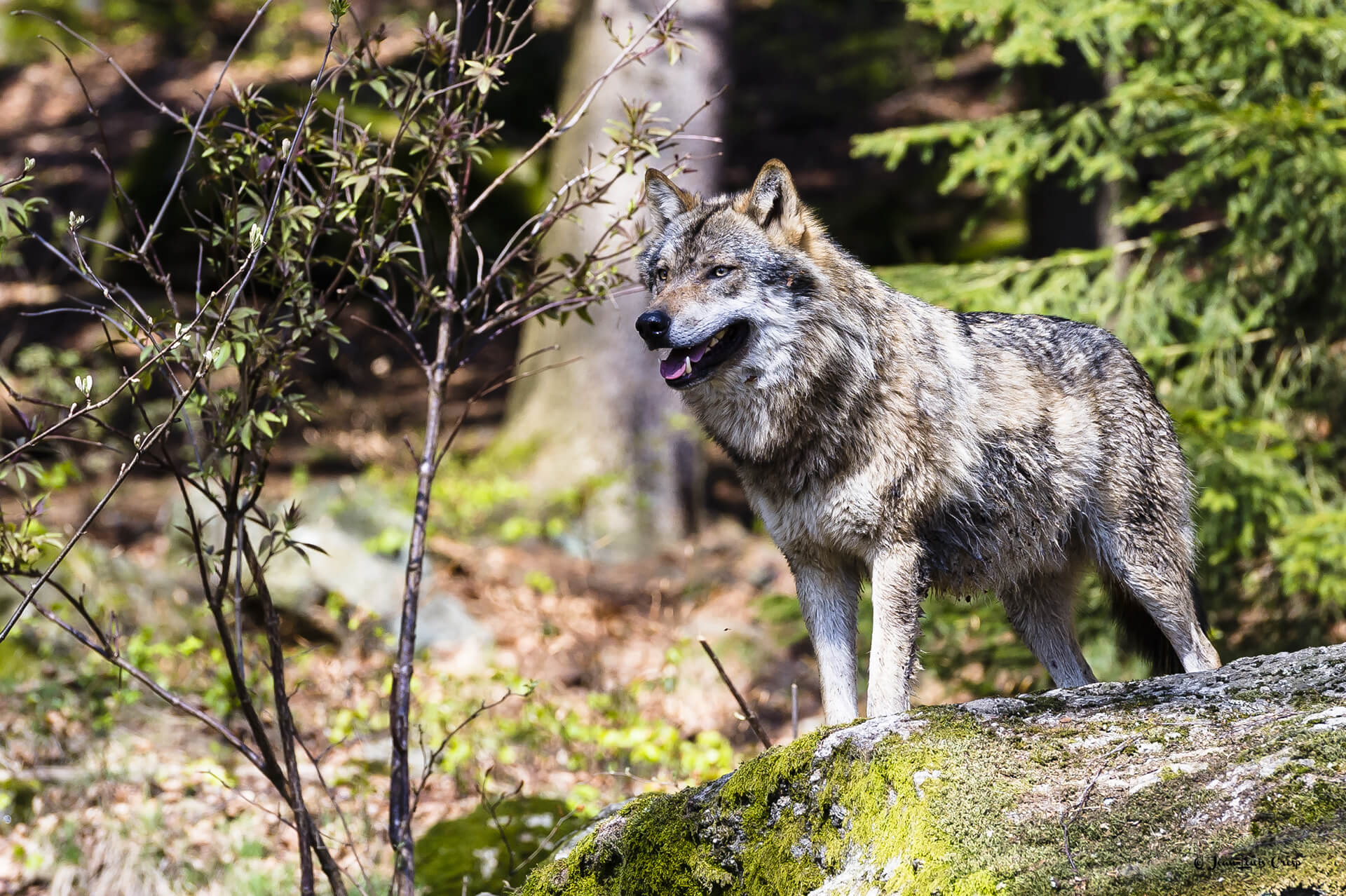
Ancestral cohabitation with Man
Hunter-gatherers have long shared the same territories as wolves. This ancient cohabitation is attested by the bones of wolves found on human sites: at Tautavel or in the Lazaret cave in Nice.
The wolf was the first animal domesticated by the nomadic peoples of the Arctic more than 12,000 years ago. This convention testifies to a mutual fascination.
It’s hard to imagine that humans thought wolves posed a danger for their survival, especially when they collected orphaned wolf cubs and entrusted them to the women of the clan! This is how the “first dogs” appeared.
Thousands of wolves killed in France in just one year !
It’s only recently that rural societies, in the service of political and religious powers, have engaged in one of the most active and effective persecutions by human beings onto another animal being. Between 1797 and 1798, 12,000 to 14,000 wolves were killed in France, at a time when guns were still rare. In 1850, their population was estimated at between 3,000 and 7,000 adults.
A law was passed in 1882 to exterminate the wolf. It even disappeared from France in 1939.
However, the specie has survived in Europe. Its potential for survival and adaptation gave it the necessary tools, better than any action in its favour, and after an absence of more than 50 years, the wolf is back in the Alps.
The great return
Originating in Vésubie (Alpes-Maritimes) since 1992, the wolf, a carnivore from Italy, has now settled all over the Alps. With “avant-gardes” in the Massif Central, the Pyrenees, and the Vosges.
The wolf’s first appearance was in 1992 in Vésubie (Alpes-Maritimes), coming from Italy. It has now settled all over the Alps. If its settling remains delicate, the wolf, unspotted for a long time, can be seen the ridges and up to the outskirts of the villages. It must be said that today there are twenty breeding packs, including 14 in the PACA region. Unsurprisingly the Monts D’Azur reserve is located in the heart of the territory of the Cheiron pack, one of the five packs in the Alpes-Maritimes department. Several clues also confirm its passage in the reserve.
After Mont Ventoux and the Montagne de Lure, settlement continues in the Sainte-Baume massif (Var and Bouches du Rhône). Dispersion is, indeed, at the core of life of the pack.
The Cheiron pack leaves the mark of its passage through the Monts d’Azur biological reserve. It can be observed thanks to dead prey, that has also been “cleaned” (especially deer and sometimes wild boar). Traces on a path, tracks in the snow and sometimes droppings confirm its passage. The howls of the pack and the young of the year, are frequently heard around the Reserve.
The return of this large carnivore implies increased monitoring of the herds but also the presence of dogs and protective nets. Even if these measures are sometimes resented by the shepherds, they’re no less effective. They have shown their worth in Italy and Spain where cohabitation is much more peaceful than in France.
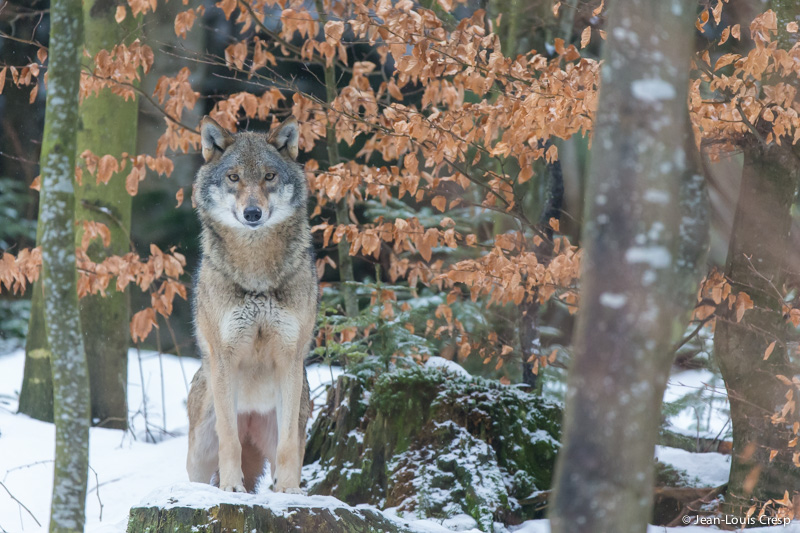
life in a pack
The social life of the wolf is organized around the dominant couple, called the “alpha couple”. They are the only one to reproduce and it is them who organize the hierarchy and the activities of the pack, accompanied by a mature adult, male or female.
In the Alps, the pack usually consists of two to three adults, with the young of that year. The “historic” packs of Mercantour include five to seven individuals, exceptionally ten. Their size varies with the amount of prey available.
Pack life is centred around caring and feeding the young, hunting, and defending the home. The latter extends over 200 to 300 km². Whelping takes place from the end of March to mid-May. Weaned at around 8 to 10 weeks of age, the cubs leave the den for the “rendezvous” site. Still too small to follow the adults, it is on this site that they will wait, alone or under the supervision of an adult, for the return of the hunt. The meeting site is abandoned in early fall.
Is his future secure?
Young wolves leave the parental territory around the age of 2 years old. They will travel tens of kilometres to find a mate, but also an available territory in order to start a new pack. This explains why in the last twenty years, the wolf has been able to settle in most of the Alpine departments, in Lozère and even in the eastern Pyrenees. Protected by the Bern Convention and the Habitats Directive, the wolf has recently been removed from the list of endangered species in France. It is expanding and is gaining ground, taking advantage of the increases in the wild ungulate populations, the expansion of the forest, and the decline of the rural world. Is its future secure ?
the wolf, an opportunistic carnivore
An opportunistic carnivore, the wolf adjusts its menu to the territory it occupies. The large wild ungulates are his preference: deer, chamois, roe deer and wild boar. It will even hunt smaller prey in the summer, such as hares, rabbits and small rodents, or carrion during harsh winters.
Between 50 and 70 large ungulates are killed by wolf packs in a year. For the record, the population of wild ungulates has increased tenfold in 30 years in France. More than 40,000 deer and does and 500,000 roe deer are killed by hunting each year.
In any case, the wolf goes for the easiest prey, avoiding any excessive risk-taking by quickly abandoning the pursuit of a prey deemed too vigorous. Hence its taste, in summer, for poorly protected herds.
Cohabiting in peace
Know the wolf well to protect yourself and live together in peace.
Large predators have a key role in the balance of ecosystems. They are the surest guarantors of the good health of herds of wild herbivores by eliminating the sick early. They also contribute to the protection of overgrazed natural areas by causing the dispersal of their prey.
Will we be able to share part of our rural territories with them or will we continue to treat them as pests ? The question remains open in France while our German, Italian or Spanish neighbours have demonstrated that it is possible to conceive of cohabitation considering the reciprocal benefits: the environmental advantages and the tourist attractions that can compensate the agricultural losses. In the USA, tourist services estimate the annual revenue linked to the presence of wolves in Yellowstone Park at 35 million dollars !
The boreal lynx (Lynx lynx)
The Eurasian Lynx comes from far away. Practically exterminated from France at the beginning of the 20th century, we owe this comeback to Swiss naturalists. At the end of the 1970s, fourteen adults were reintroduced to the Swiss Jura. To such success that we found (in the mid-80s) lynxes in the department of Ain. To reinforce this settlement, about twenty individuals were introduced in the Vosges in 1983. There doesn’t yet seem to be any exchange between the two populations.
In total, the French population is less than 200 adults. Suffice to say that it remains very fragile in the face of human pressures.
Observations of a male, a female, and foal were made in the Alpes-Maritimes, between Mons, Faïence and Thorenc in 2007 – at the south of the Alpine arc. Many mysteries remain on the settlement and the movements of the felines settled there.
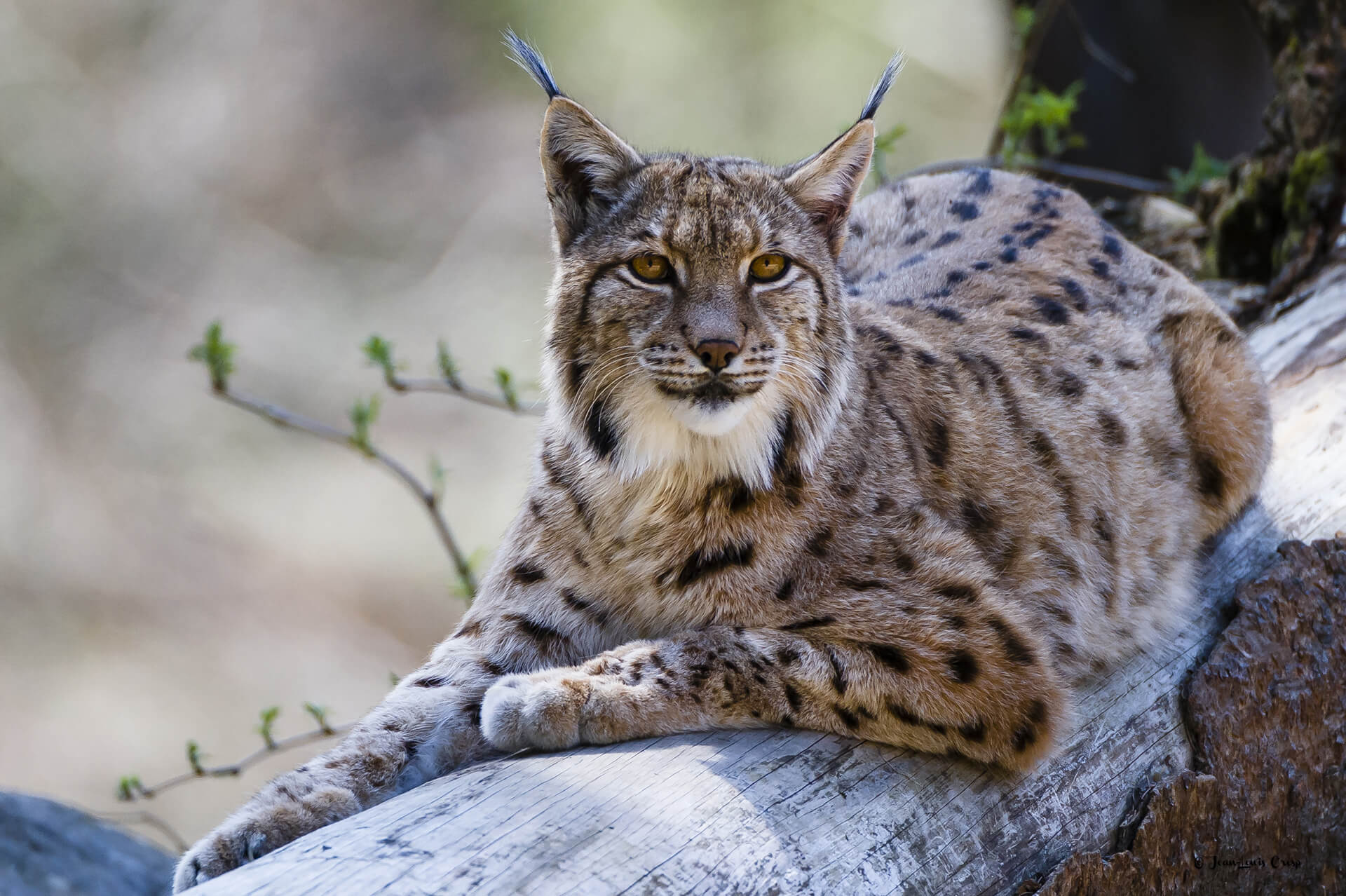
A discreet and solitary forestry
The lynx is an animal that lives in solitude all year on a territory ranging from 90 km2 for females, to 250 km2 for males. A discreet animal, it rarely leaves the forest cover and is reluctant to venture out into the open over long distances. It moves along wooded corridors, regularly using tracks or forest paths. It looks for rocky covers that offer it shelter or a den, as long as its favorite prey can be found there !
Deer, a favorite prey of the lynx
The lynx’s favorite pray is the deer, the same way cats favors mice. It’s unsurprising that its return has accompanied the spectacular increase in deer numbers.
The lynx eats about 1 to 3 kg of flesh per day. This represents about 60 ungulates per year (roe deer 70%, chamois 20%, other prey 10% including the fox).
It hunts, first on the lookout it leaps at a very short distance on its prey and kills it, after having pushed it down with its foreleg, after a bite on the throat or the nape. The muscles of the thighs and the liver are consumed first (three observations). This makes it possible to make the difference with the wolf which first opens the rib cage (six observations).
The lynx can return to its prey to consume it for several days in a row. The skin is then gradually rolled up towards the head.
brief stormy weddings
Males and females only meet during the mating season, in February-March. The night resounds with brief and powerful growls, “WAaaou”, yelled by the male (two plays in 2009 and 2010). The nuptials are brief and only last a few days. The couplings remain lively and agitated and from these embraces, the female often keeps bites on the spine.
She will raise two to three young on her own, returning to her den after nocturnal hunts in the first few weeks. Then, the female will regularly change refuge. It is easier for the male to move his young than to transport a killed prey !
High-risk emancipation
The emancipation of the young is sudden, from January to April, when the next breeding season arrives. The female pushes them to leave her territory. It’s the most critical period of the lynx’s life. Still inexperienced in hunting, they must learn to survive in unknown places and face multiple dangers. Fatalities are common on roads and railways. It also happens that these undernourished and weakened carnivores are collected near dwellings, as in the Jura in 2009.
Feline presence at Thorenc
The presence of the lynx in and around the Monts d’Azur Biological Reserve has only been confirmed recently: we observed a female and her young in 2007, corpses of roe deer killed and eaten in 2006, 2007 and 2008.
A group of deer, made up of a dozen individuals, was suddenly displaced during the winter of 2008-2009. Undoubtedly the permanent presence of a settled female. During the winter of 2009, our guides noticed regular calls from a buck under the rock bars, tracks in the snow, and a dead deer with skin rolled up on its head. We have yet to see this invisible prowler… To do this, a photographic trap has just been installed.
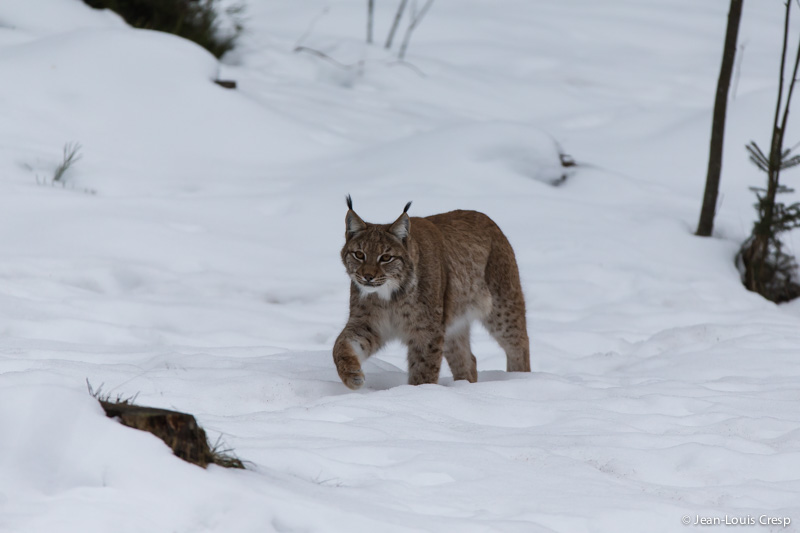
the red foxVulps vulps
The red fox is present all over the world and in all environments. Its adaptability seems limitless and its mind remarkably sharp. Small (35 cm at the withers), this carnivore hides under thick fur varying in tone from brown to yellow.
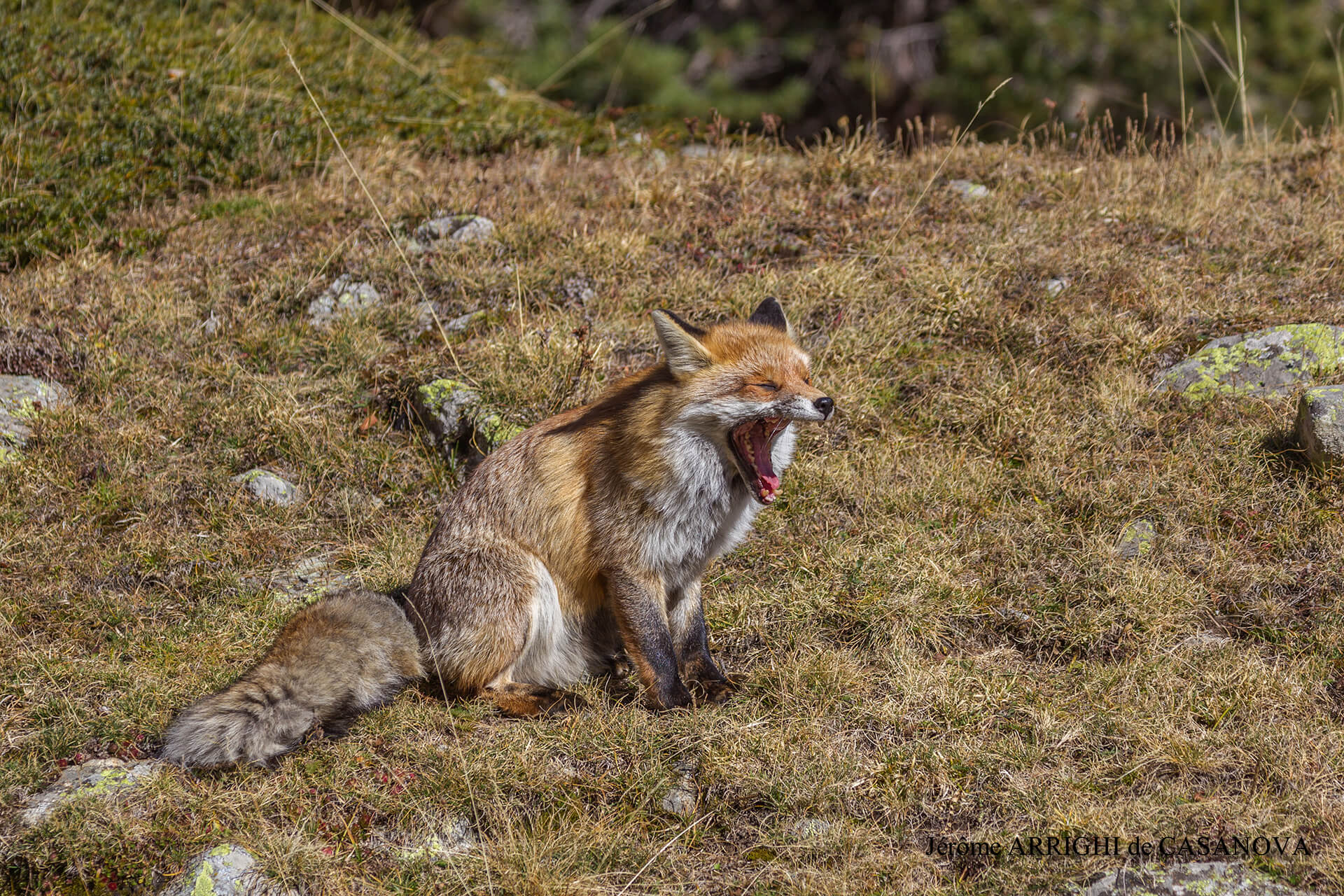
Common species if any...
The male fox marks its territory by means of its faeces (excreta) but also by loud nocturnal cries, particularly audible in February.
After a gestation of 8 weeks, the vixen gives birth to three to seven babies, in a burrow more or less arranged by her care. It is not uncommon for the fox to exploit the digging talents of the badger, by settling in the upper parts of the burrow. Born blind, the young will remain in the burrow for 2 to 3 weeks. They will come out on sunny days to play while the mother hunts. They are then of a grayish color and have a plump abdomen, a globular skull, a nose and short ears.
The mother returns to nurse them regularly as they age, and brings them small prey. In time they will begin to follow her movements and will learn the hard job of being a predator.
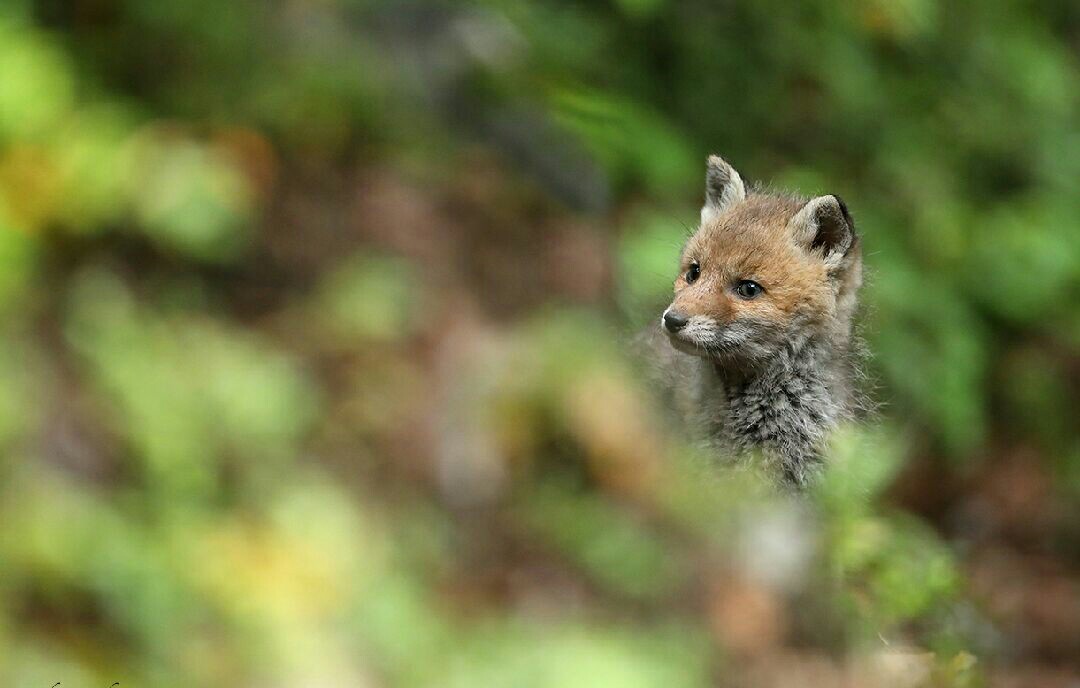
The red fox : adaptable and exterminator
The fox is an opportunistic animal, able to adapt to all situations. Its habitat ranges from dense forests, to grasslands and to the heart of cities. It is very skilled at exterminating rats ! We can find foxes on the Reserve sometimes stealing shoes but mainly hunting small rodents, birds and also grasshoppers! In autumn, they feast on wild fruits: blackberries, raspberries or rosehips.
Your roommate
A discreet but curious animal, this carnivore doesn’t hesitate to enter the lodges at nightfall. The luggage of our visitors is then carefully inspected and beware of poorly stored shoes… They will end up in the burrow !
Apart from that, it is a pleasant companion to observe especially when hunting. It alternates cautious movements and spectacular leaps that allow it to capture a multitude of prey, even the smallest one.
badgerMeles meles
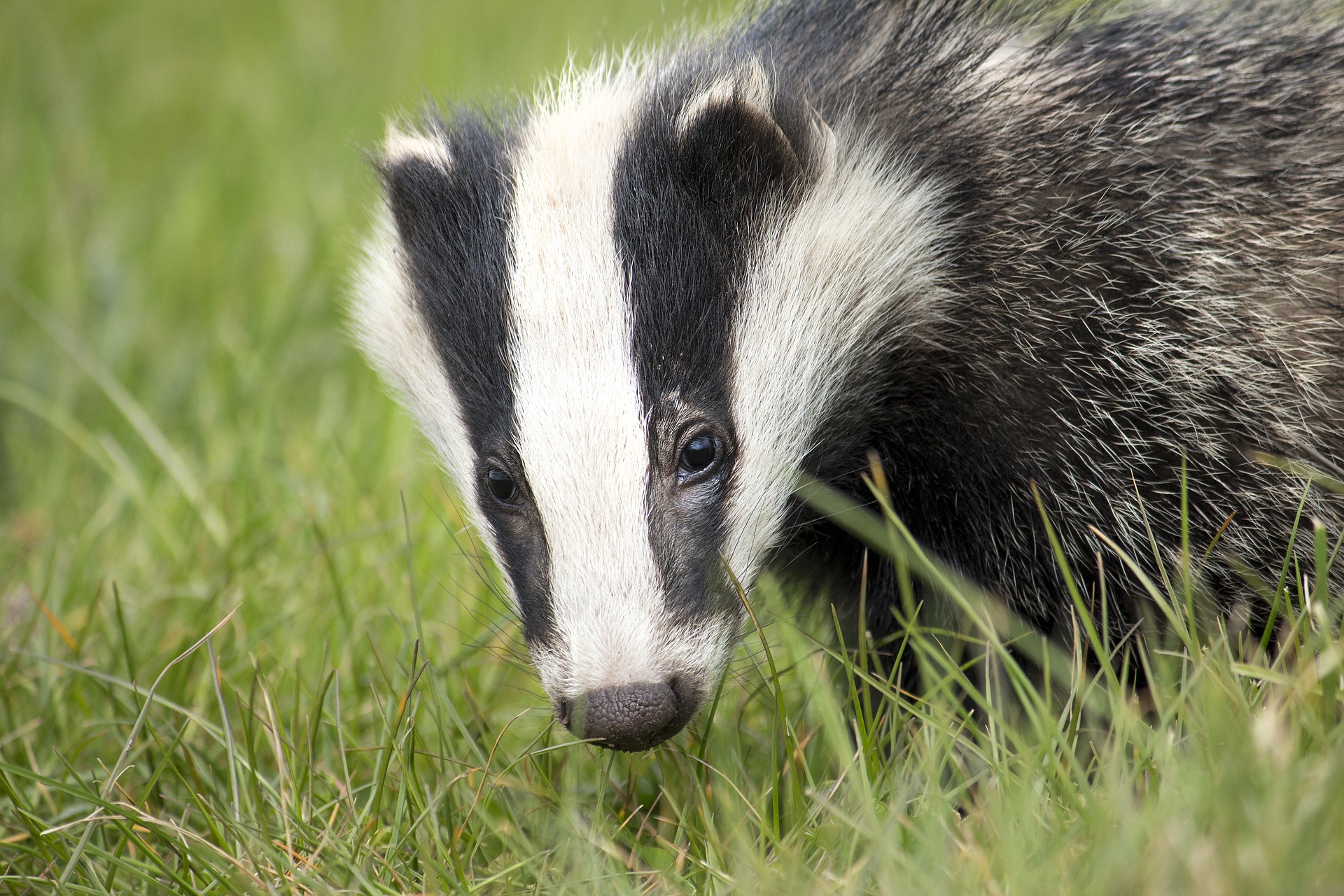
Just as common as the fox...
Badgers occupy all of Europe with the exception of the most northern territories. With a preference for the forests where they are more comfortable than in the meadows.
There are many writings that relate it to a miniature bear. Its looks, its awkward walk, its teeth and even its pace of life, which includes a half-winter sleep, could relate him to the large European carnivore. But the badger is only a mustelid, like the weasel or the stone marten. And if it is carnivorous, it is with moderation.
It is robust, muscular, and reaches 25 kg. It has short and powerful legs. Especially the forelegs which, armed with powerful nails, allow it to dig its burrows.
...but a little more of a homebody
The badger loves routine. This allows beautiful observations when the burrow has been spotted. It lives there with his family. The rut takes place in the heart of summer and the births occur in February when the mother is in hiding for the winter period. The young will complete their development outside their mother’s womb.
Adults can emerge from their burrows as early as February. The little ones will wait for the beginning of spring. As with the fox, the observation of the young is very entertaining. To be heard: the babies’ small grunts that make these moments magical.
The badger is a very clean animal. Its burrow is cleaned daily and the entrance does not show traces of the last feasts, as is often the case for the fox. It goes so far as to dig small holes in the ground to deposit its droppings.
A very diversified diet
The badger is an omnivore. In summer and autumn, its diet consists of insects, worms, snails, many plants, bulbs and roots and small sweets such as fruits, honey and mushrooms.
More occasionally, it can adopt a carnivorous behavior, it consumes frogs, reptiles – including vipers – small mammals such as field mice… In the Reserve, it remains discreet except during the mating period when it brings home anything lying around !
